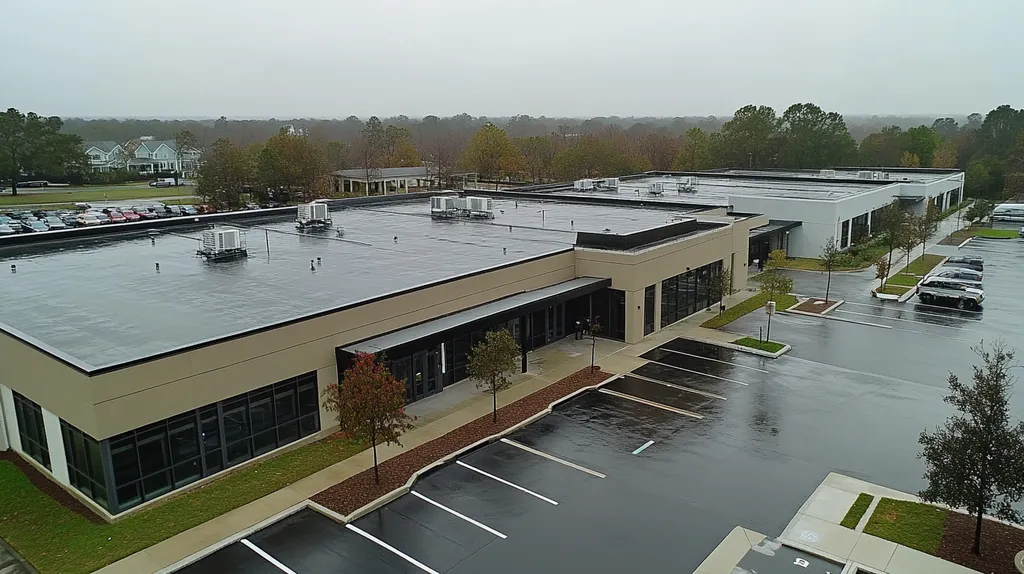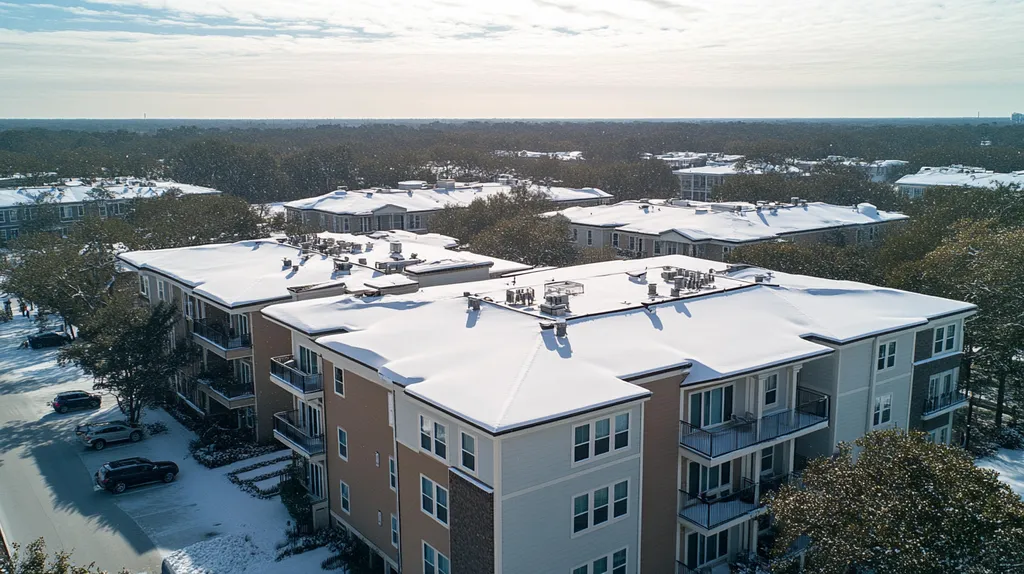In commercial roofing, timing mistakes can cost property owners up to $100,000 in weather-related damages annually. Yet nearly 40% of roofing projects face delays due to inflexible work schedules that fail to account for building operations and weather conditions.
Understanding how to optimize work hours for roofing projects has become crucial for protecting both investments and occupant satisfaction. From managing tenant disruptions to maximizing material performance, flexible scheduling can make or break a project’s success.
This guide explores the essential aspects of adapting work hours for commercial roofing projects, providing property owners and facility managers with actionable strategies to enhance efficiency while minimizing operational impact.
SECTION 1: THE BASICS EXPLAINED
In the world of commercial roofing, timing can make or break a project. When project schedules don’t align with the needs of a building, it often leads to skyrocketing costs and frustrated tenants. Research indicates that misaligned projects can extend timelines by almost 30%. To prevent such setbacks, adapting work hours to meet project demands is vital for ensuring both efficiency and effectiveness. This section delves into what flexible work hours truly mean, why they are important for property owners, and how they can be put into action.
What It Is (In Plain Language)
Flexible work hours in roofing projects involve tailoring the timing of work to optimize resources and reduce interruptions. This could mean starting work at dawn, continuing late into the night, or even scheduling tasks on weekends. The objective is to synchronize the roofing project with the specific needs and routines of the building and its occupants.
For example, a bustling office building might prefer roof maintenance to occur after hours or over the weekend to prevent disturbances during the day. By adjusting work hours, contractors can accomplish roofing tasks effectively while ensuring that daily operations remain undisturbed.
This flexibility goes beyond just being considerate; it’s a strategic method to streamline project timelines and improve results. Buildings can experience significant benefits from a schedule that aligns smoothly with their operational demands.
Comprehending this concept is essential for property owners aiming for a successful and timely roofing project.
Why It Matters (To Your Building)
Implementing flexible work hours can greatly influence a building’s functionality and safety. When roofing work is poorly scheduled, the potential for delays increases, leading to unexpected expenses. For instance, a project that drags on beyond its intended timeline often incurs extra labor costs and additional equipment rentals.
Moreover, disruptive noises and disturbances during regular business hours can upset tenants and disrupt their activities, impacting tenant satisfaction. Since retaining tenants is critical for property owners, creating a tranquil environment becomes imperative. Thoughtful work schedules help ensure minimal intrusion, which enhances tenants’ overall experience.
Additionally, being adaptable with work hours is particularly vital for complex roofing projects that require significant materials and manpower. This flexibility helps keep projects on track and within budget.
In summary, the way work hours are structured directly influences both the operational efficiency and financial viability of a property.
How It Works
Effective implementation of flexible work hours starts with strategic planning and open communication among all parties involved. Facility managers should work hand-in-hand with roofing contractors to pinpoint the most efficient work schedule. This process includes evaluating peak business hours and identifying any unique concerns that might arise during the project.
For instance, during a roof replacement, it may be beneficial to schedule noisy demolition activities for non-peak hours, allowing quieter tasks to occur during high-traffic times. This proactive planning leads to a smoother workflow and reduces stress levels for tenants and workers alike.
Furthermore, technology plays a crucial role in facilitating these efforts. Real-time scheduling software can help track ongoing progress and enhance communication. Such tools allow property owners to make quick, informed decisions as projects evolve.
By embracing flexible work hours, organizations can not only complete roofing projects efficiently but also enhance overall satisfaction for both property managers and building occupants. In the end, these adjustments present a win-win situation for everyone involved.
SECTION 2: PRACTICAL APPLICATIONS
The stakes in commercial roofing are significant—poor planning can lead to extensive property damage that can cost over $100,000 annually for a single property due to weather-related issues. Understanding how flexible work hours can be tailored to meet project demands is crucial for mitigating these risks and enhancing project efficiency. This section explores common applications of flexible work hours, the critical moments when adaptability is necessary, and the importance of synchronizing roofing work with other systems.
Common Uses & Examples
Flexible work hours can play a vital role in executing roofing projects effectively, especially in regions where weather can be unpredictable. By allowing roofers to alter their schedules, property managers can ensure that critical installations or repairs take place during optimal weather conditions.
For example, in northern climates, roofing tasks might be scheduled for milder months to avoid delays caused by snowfall. Conversely, southern properties may benefit from early morning or late evening work to sidestep extreme heat, conserving both the wellbeing of workers and the quality of materials.
In densely populated urban areas, nighttime installation could minimize the disruption to everyday operations, enabling the project to proceed without interrupting tenant business hours. Proper planning to incorporate flexible hours is essential for optimizing timelines and achieving successful results.
What’s more, the ability to quickly respond to sudden weather changes allows roofing crews to adjust their shifts. For instance, if rain is forecasted, shifting workers to earlier hours can ensure that critical tasks are completed before inclement weather strikes.
When You Need It Most
Specific situations require flexible work hours to protect both the roof and the activities occurring beneath it. Seasonal peak times emphasize the need for adaptive scheduling, particularly in climates prone to extreme weather changes.
In regions with significant temperature fluctuations, roofing projects should be designed to take advantage of prevailing seasonal patterns. For example, being proactive during transitional weather periods can help avert costly delays and safeguard roofing materials from damage.
Additionally, urgent repairs in the aftermath of storms or natural disasters call for swift action. By maintaining a workforce capable of mobilizing outside traditional hours, facility managers can address leaks or structural concerns before they escalate into serious issues.
While tenants might not always see the behind-the-scenes efforts, unexpected disruptions during business hours can lead to dissatisfaction and lost revenue. Utilizing transparent communication and responsive scheduling helps reduce these impacts, ensuring that both the roof’s integrity and facility operations stay intact.
Interactions With Other Systems
Adopting flexible work hours can positively influence various systems within a facility, including HVAC, electrical, and plumbing services. Coordinating scheduling is essential to minimize conflicts and maximize overall efficiency in multi-trade environments.
For instance, if roofing work coincides with HVAC system upgrades, careful planning ensures that both projects proceed smoothly without compromising safety or progress. When contractors and facility managers collaborate on schedules, they can avoid unnecessary interruptions or hazards that might disrupt building operations.
Furthermore, effective scheduling supports the preservation of existing workflows. By alerting other departments in advance, businesses can ensure coordination and avoid conflicts during roofing activities and other critical infrastructural updates.
Emphasizing adaptability in work hours not only enhances roofing projects but also addresses the unique demands of each facility. This comprehensive approach fosters a seamless integration of roofing requirements with overall facility operations, leading to improved outcomes for everyone involved.
SECTION 3: KEY TERMINOLOGY DECODED
Understanding roofing terminology is essential for property owners and facility managers. Misinterpretations can cause significant delays and drive up costs in roofing projects. For instance, unclear terms around project scope can lead to disappointing results or unnecessary downtime for organizations. This section clarifies key terms, translating complex industry jargon into straightforward language to aid decision-making.
Essential Terms Explained
In the roofing industry, several key terms define project specifications. One important term is “TPO,” which stands for thermoplastic polyolefin—a lightweight roofing membrane celebrated for its energy efficiency. Grasping these terms is vital for selecting the most appropriate materials for a project.
Another significant term is “dew point,” which refers to the temperature at which moisture begins to condense. Knowing the dew point is crucial for ensuring effective roof insulation, helping to prevent moisture buildup that could result in costly repairs down the line.
“R-value” is a term that property owners encounter frequently. It measures thermal resistance, indicating how well a roofing system retains heat. A higher R-value translates to better energy efficiency, which can directly lower heating and cooling costs.
Finally, “flashing” refers to materials used to seal joints on the roof. Proper installation of flashing is paramount to eliminate leaks, thus protecting the roofing investment and prolonging its lifespan.
Industry Jargon Translated
Many roofing terms may sound like jargon, but they have significant implications. For instance, “ballasted roofing” describes systems using heavy materials, like gravel, to secure the roofing membrane. This understanding is key to evaluating the structural weight load a building can support.
Another relevant term is “built-up roofing” or BUR, characterized by multiple layers that offer durability and moisture defense. Recognizing the differences between BUR and single-ply systems can shape long-term maintenance and performance expectations.
The term “roof pitch” denotes the steepness of a roof. Roof pitch impacts water drainage and snow accumulation, affecting the types of materials that can be effectively used.
Lastly, “foam roofing” refers to a system employing spray polyurethane foam to create a seamless, insulated roof. This modern solution is gaining popularity and represents an innovative growth area in the roofing industry.
Measurement & Units Simplified
Measurements in roofing often involve terms like “square feet” and “squares.” A “square” is equal to 100 square feet of roofing material. This terminology is critical for accurate cost estimates and coverage assessments.
The term “inches” also plays a vital role, especially in discussions about roof slope and drainage. Proper drainage is essential for a roofing system’s longevity; an incorrect slope can lead to water pooling and eventual leaks.
Another significant measurement is “mill thickness,” which indicates the thickness of roofing material. Thicker materials often offer better durability, making it crucial to choose the appropriate system for specific environmental conditions.
Understanding these units simplifies decision-making, enabling property owners to accurately anticipate project materials and costs. A solid grasp of these measurements ensures that projects run efficiently and smoothly, minimizing disruption for everyone involved.
SECTION 4: DECISION FACTORS
When it comes to commercial roofing, making informed decisions is crucial. Factors like cost, performance, and longevity significantly influence both immediate expenses and the future integrity of the building. Failing to consider these aspects can lead to costly mistakes and damage, affecting not only budgets but also the safety of occupants. Thoughtfully evaluating how work hours adapt to these factors can lead to better project outcomes, ensuring that investments are well-protected over time.
Cost Considerations
Budget limitations often dictate how roofing projects are planned, and efficient scheduling can make a significant difference. For instance, undertaking work during off-peak hours can lower labor costs and reduce material wastage by allowing crews to focus on their tasks without interruption.
Additionally, projects that stretch beyond standard hours often incur overtime pay, quickly ballooning the budget. By thoughtfully aligning the work schedule with the workforce’s availability, property owners can avoid unnecessary financial burdens. It’s vital to find the right balance between cost and quality to guarantee that every investment yields maximum value.
Hidden costs can crop up if projects aren’t envisioned properly from the start. Rushing a job can lead to mistakes that result in callbacks for repairs, raising overall expenses. In contrast, a well-paced project with a clear timeline can help prevent these issues, keeping the work within budget.
In summary, effectively managing work hours can lead to substantial savings while improving project quality. A strategic approach not only minimizes roofing expenses but also secures better outcomes for property owners.
Performance Trade-offs
Finding the right balance between scheduling and performance is critical in roofing projects. Weather conditions can impact material effectiveness, making it essential to choose optimal work hours. If crews work in unsuitable weather, they risk compromising the integrity of the roofing system.
For instance, installing roofing materials during extreme temperatures may result in adhesion issues, putting the entire roof at risk. By planning installations for favorable conditions, property owners can enhance material performance and longevity.
Moreover, coordinating work hours with other ongoing maintenance can streamline operations. Uninterrupted work schedules during off-hours allow different trades to cooperate without conflict, boosting overall productivity. This synchronization promotes a smoother workflow, eventually minimizing project time.
By being mindful of these trade-offs, property owners can optimize performance and lessen future maintenance costs. Neglecting to consider how work schedules affect performance may lead to early wear and tear on roofing systems, resulting in higher expenditures down the line.
Lifespan & Durability Factors
The timing of installation efforts significantly influences the lifespan and durability of roofing materials. High-quality materials need careful placement under precisely controlled conditions to achieve their full potential. If roofing work is rushed or poorly timed, the expected lifespan of the materials may diminish dramatically.
For example, installing roofing materials designed for cooler weather during a heatwave can cause them to wear out prematurely. A clear understanding of how work hours relate to durability helps property owners establish the right schedule for their specific roofing needs.
Regular maintenance also plays a vital role in enhancing the structure’s longevity. Aligning lighter maintenance tasks with flexible work hours can help property owners respond quickly to wear and tear, reducing the risks of significant damage. Conducting inspections during optimal hours ensures that potential issues are caught early.
Ultimately, focusing on lifespan and durability allows property owners to balance upfront costs against long-term benefits. By adopting flexible work hours for roofing projects, they can secure a strong return on their investment and avoid future headaches.
SECTION 5: COMMON CHALLENGES
Managing commercial roofing projects is fraught with potential pitfalls that can derail timelines and inflate costs. Factors like unpredictable weather and communication breakdowns often lead to budget overruns and safety hazards. In fact, about 30% of roofing projects face delays due to unforeseen circumstances. Recognizing and addressing these challenges is essential to keeping projects on track. This section highlights common issues, warning signs to look out for, and preventative strategies to help mitigate risks.
Frequent Problems & Solutions
Weather conditions significantly impact commercial roofing outcomes. Rain, high winds, or extreme temperatures can halt work and push back timelines. To counter this, property owners should collaborate with contractors to create flexible schedules that allow for quick adjustments in response to changing weather patterns.
Labor shortages are another recurring challenge. A shortage of skilled workers can stall progress, making it vital to maintain relationships with a network of reliable subcontractors. This way, property owners can ensure their projects keep moving forward, regardless of workforce fluctuations.
Communication breakdowns among stakeholders also hinder project efficiency. When expectations and timelines are unclear, alignment becomes difficult. Establishing a transparent communication plan can help ensure everyone stays on the same page, improving project coordination.
Finally, supply chain disruptions can lead to delays in obtaining necessary materials. Property owners can safeguard against this by ordering materials well ahead of time, creating a buffer to account for unexpected delays.
Warning Signs To Watch For
Property owners need to remain alert for signs of potential roofing project complications. Frequent delays, even minor ones, might indicate underlying issues, such as labor shortages or scheduling conflicts. Keeping a close eye on timelines can enable quick interventions, preventing more extensive delays.
A sudden spike in material costs can also signal trouble. If prices increase unexpectedly, it may be indicative of weaknesses in the supply chain. Regularly assessing supplier reliability can help property owners stay ahead of potential issues.
Another red flag is inconsistent communication among team members. If meetings are missed or information isn’t shared timely, it can lead to disarray. Establishing a regular check-in schedule encourages open lines of communication and helps maintain project alignment.
Lastly, safety compliance is non-negotiable. Frequent lapses, like missed inspections or training updates, should raise alarms. Consistently monitoring safety practices is crucial in preventing accidents and ensuring project continuity.
Preventative Approaches
Adopting flexible scheduling can be a game-changer for avoiding common roofing challenges. Property owners should partner with roofing professionals to establish schedules that allow for real-time adjustments, accommodating unexpected developments.
Building solid relationships with several trusted subcontractors serves as another proactive step. This diversified network ensures that if one crew becomes unavailable, others can be called upon to keep projects on track.
Regular training sessions for both crews and management can help foster clearer communication and promote safety compliance. These meetings should focus on reinforcing project goals and safety protocols to ensure everyone is aligned.
Finally, conducting thorough and regular inspections of materials and safety practices can help detect potential challenges before they escalate. This proactive approach allows property owners and managers to nip problems in the bud, streamlining project progress and minimizing disruptions.
SECTION 6: NEXT STEPS & RESOURCES
Adapting work hours for roofing projects is not just a nice-to-have; it’s essential for minimizing disruptions and keeping projects on track. When roofing is poorly timed, property owners risk facing costly delays and safety issues. In fact, a staggering 30% of construction delays can be traced back to mismanaged work hours. By taking thoughtful steps today, property owners can pave the way for successful roofing projects and ensure the long-term performance of their buildings.
Questions To Ask Providers
When selecting a roofing provider, the right questions can make all the difference. First, ask about their experience with flexible scheduling. Since properties often have unique operational needs, it’s crucial to understand how providers accommodate for minimal disruption during working hours.
Next, inquire about their safety protocols in place for extended hours. Ensuring compliance with OSHA regulations is pivotal for protecting both workers and the property (source: Occupational Safety and Health Administration).
In addition, check whether they can provide emergency repair services outside typical hours. Since roofing issues can arise unexpectedly, having a provider ready to tackle urgent problems can prevent further damage.
All these discussions should lead to clear expectations concerning project timelines and costs. A reliable provider will present a comprehensive plan that aligns with both your budget and operational needs.
Industry Standards & Guidelines
Being informed about industry standards is crucial for successful roofing projects. Organizations like the Roofing Industry Alliance for Progress offer guidelines that outline best practices for work scheduling and safety protocols during installations.
The National Roofing Contractors Association (NRCA) provides additional resources tailored for flexible work hours in commercial settings. These standards help establish protocols that promote both safety and quality craftsmanship.
It’s also wise to review local regulations that may dictate permissible work hours, especially in bustling urban areas. Compliance with these rules can safeguard property owners from potential fines and ensure a smoother project experience.
Investing time in understanding these standards not only enhances operational efficiency but also boosts satisfaction with roofing outcomes in the long run.
Further Learning Simplified
To empower property owners and facility managers, exploring additional resources is key. Websites like the National Roofing Contractors Association provide a wealth of educational materials on various roofing topics.
Webinars focusing on roofing project management can deepen understanding of how to leverage flexible schedules effectively. These opportunities create pathways for sharing knowledge and best practices.
Local trade shows often feature roofing seminars that offer firsthand insights from industry leaders. Engaging directly in these discussions fosters valuable knowledge-sharing for upcoming projects.
Lastly, subscribing to industry publications can keep stakeholders informed about the latest trends, including innovative scheduling strategies in the roofing sector.
The Bottom Line
With weather-related roofing damages costing commercial properties up to $100,000 annually, the importance of optimizing work hours cannot be overstated.
Flexible scheduling serves as the cornerstone of successful commercial roofing projects, directly impacting everything from material performance to tenant satisfaction.
By implementing adaptive work hours, property owners can reduce project delays by up to 30% while maintaining building operations and protecting their investment.
The future of commercial roofing lies in this strategic approach to timing – one that balances weather conditions, tenant needs, and material requirements.
Moving forward, property owners who embrace flexible scheduling will find themselves better equipped to tackle roofing challenges while maintaining operational efficiency and protecting their bottom line.
FREQUENTLY ASKED QUESTIONS
Q. What are flexible work hours for a commercial roof project?
A. Flexible work hours adapt the timing of roofing tasks to minimize disruptions. This can mean working early, late, or on weekends to align with business routines. By synchronizing project schedules with the needs of property occupants, contractors can achieve efficiency and effectiveness in roofing projects.
Q. How can flexible work hours help manage industrial roof projects?
A. Flexible work hours are crucial in industrial roofing, especially during unpredictable weather. By scheduling work based on optimal conditions, such as milder temperatures, property managers can minimize delays. It also allows for essential repairs after hours, ensuring business operations remain uninterrupted and the roofing work can proceed effectively.
Q. Why are flexible work hours important for commercial roof projects?
A. They significantly reduce costs and prevent project delays. When work is scheduled to fit around business operations, disruptions to tenants are minimized. This strategic timing leads to an efficient workflow and ensures that roofing tasks align with the operational needs of the facility.
Q. What measures can enhance flexible scheduling for commercial roofs?
A. Effective communication between property managers and contractors is essential. Additionally, utilizing real-time scheduling software can allow for dynamic adjustments as conditions change. Planning around peak business hours and keeping all stakeholders informed will lead to smoother project execution and minimized disruptions.
Q. How do common roofing challenges affect flexible project hours?
A. Challenges like unpredictable weather or labor shortages can complicate timelines. When these issues arise, having a flexible schedule allows teams to adapt swiftly, executing work during favorable conditions. This adaptability helps maintain project momentum and reduces the risk of costly delays.
Q. What industry resources can help with flexible work hour implementation?
A. Organizations like the National Roofing Contractors Association offer resources and guidelines on best practices. Educational materials and webinars can provide insights on scheduling and managing projects. Consulting these resources can empower property owners and managers to implement effective strategies for flexibility.
Q. How can property owners maintain communication during roofing projects?
A. Establishing regular check-ins and updates among all stakeholders is key. Utilizing technology for real-time updates keeps everyone informed of progress and any necessary adjustments to the schedule. Clear communication prevents misunderstandings and helps maintain alignment throughout the project.











